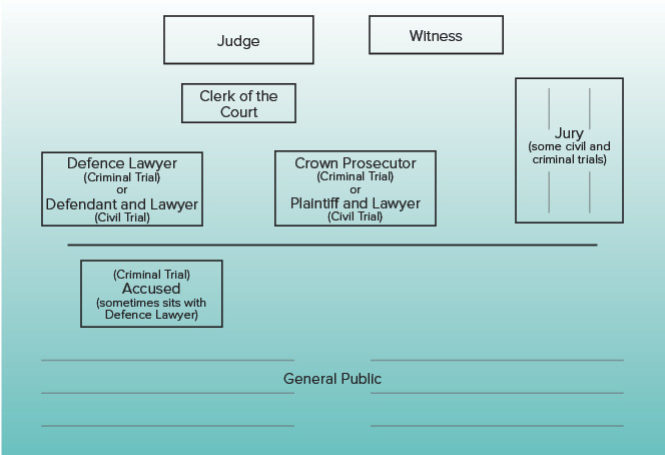There are many different people involved in any court case, each with their own role to play. Understanding these roles can help make sense of the court proceedings.
Crown Prosecutor
Lawyers hired by the government to prosecute criminal cases are called Crown Prosecutors. They present the evidence against the person charged with a crime to try to establish the guilt of the accused to the judge or jury. Crown Prosecutors do not work for the individuals involved in the case – they act for the state. They are required to present the case fairly.
Lawyers
In criminal matters accused individuals may be represented by a defence lawyer. In a civil case each party may have their own lawyer. Lawyers present evidence to the court to help their client tell their side of the situation.
Accused
A person charged with a crime is known as the accused or the defendant. They may have a lawyer to present their side of the case to the judge or jury.
Plaintiff & Defendant
If it is not a criminal court case, the person who alleges that something wrong has been done is usually called the Plaintiff. The person accused of having done wrong is usually called the Defendant.
Petitioner & Respondent
In family law cases, dealing with things like divorce, custody or financial support, the person who starts the case is called the Petitioner. The other party is called the Respondent.
Justice of the Peace
Justices of the Peace are Saskatchewan justice officials who do things like issuing arrest or search warrants. Sometimes, at an early stage of a criminal court case, an accused person appears before a Justice of the Peace instead of a judge. However, Justices of the Peace do not conduct criminal trials or sentence people.
Trial Judge
The judge oversees the trial to ensure everyone is treated fairly and has a chance to tell their side of the story. The judge decides how the law applies to the case being tried.
Jury
In some cases there will be a jury as well as a judge. Juries are made up of regular people from the community. When a jury is needed, the Sheriff calls a number of randomly selected people to court. The lawyers representing the two sides choose the jury from these people.
The judge explains the law to the jury. At the end of the trial, the jury leaves the courtroom and meets to decide on the outcome of the case. These meetings are secret. If it is a criminal case all jury members must agree for someone to be found guilty.
Court Staff
Other people work in the courtroom. The clerk of the court helps the judge, announces when the proceedings begin and end, and records the evidence exhibits. If an accused person or a witness is in custody, the Deputy Sheriff goes with them to court. The Deputy Sheriff also helps to maintain order in the court.

